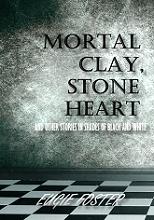Okay, I’m fanatical about keeping records when I write.
– Yearly chart – documents story title, working title (if any), date completed (zero draft), done status (complete, in progress, not complete–for those things I’ve tabled indefinitely), # words, and marketing status (Out, Sold, up for Critique) based upon year.
– What’s Out – this is my most consulted record – documents everything that’s out and at what markets, date of submission, word count (again), what I’ve sold to which market, and how much they paid/are paying me.
– Response Times – logs what markets I’ve submitted to, how many times to each, what individual response times were, the max, min, and mean times per market, whether I’ve sold to them, and # of rejections between sales.
– Individual Story Logs (one for each completed story) – title, current in-country postage, page count, word count (yes, again), overseas postage if it’s gone to an overseas market, appropriate markets and their pay scale based upon preference of submission for that story, date of submission per market, date of rejection/sale per market, and any notes (e.g. queries, short-listings, reading dates, responds by email, etc.)
– Critique logs – lists comments by type per story, how many people suggested it, whether I agreed with the suggestion, and if I made the change. Sometimes, I do a count here if I asked a specific question for critique to log the “yay” and “nay” answers.
– I also keep every critique I’ve ever gotten for every story.
– And I save every prior draft of every story in case I decide that a re-write I did ruined the thing and need to revert it back to a previous version.
– And I also keep a “hold” document for most of my stories to keep sections that I cut out during re-write/editing that I really liked. Mostly so it hurts less when I cut them, but also in case I decide later I shouldn’t have and want to put it back. I also keep research notes pertinent to a story here, unless they’re extremely extensive in which case it gets its own document.
– And finally on hard-copy I keep folders for each story to put every piece of correspondence about it in. Even form rejections.
I used to keep a spreadsheet that color coded where a story was and for how long it’d been there based on month, but that didn’t really convey any information that I didn’t have from my other records, so I quit updating it.
It’s sick. Sick I tells you! But, also kind of fun and useful to keep tabs on trends in my writing.
I remember hearing one of the presenters at a writers panel discussion at World Con several years ago say that she spends a huge chunk of time on marketing and record-keeping. She views writing as two separate occupations: writing and the business of writing.
I agreed with her completely and was glad to know I wasn’t the only one.









Wow.
I am much less organized than this. I keep a copy of the submitted manuscript and a copy of the cover letter (which has the date sent, or close to it), and then in the same folder I put acceptances and contracts, and information on readings (like directions to the bookstore). I don’t always keep rejections, especially if they arrive via email; too much paper.
And I also keep a “hold” document for most of my stories to keep sections that I cut out during re-write/ editing that I really liked. Mostly so it hurts less when I cut them, but also in case I decide later I shouldn’t have and want to put it back. I also keep research notes pertinent to a story here, unless they’re extremely extensive in which case it gets its own document.
I do this. Sometimes the cut bits are useful for something else, or hold information I need for backstory if not for the actual story.
Re: Wow.
I’m not sure if I’d call it “organized” so much as obsessive-compulsive! Eep.
Actually, I tried keeping hard copies of everything I wrote too, but I kept making little changes, and then having to print out the whole thing again, and forgetting to throw away the previous versions, and then I’d end up with a whole stack of printouts that I didn’t need without an easy way to tell which ones I could pitch. It got ugly quick. So now I just make two sets of backups: an electronic one and I burn my whole writing file to CD every month.